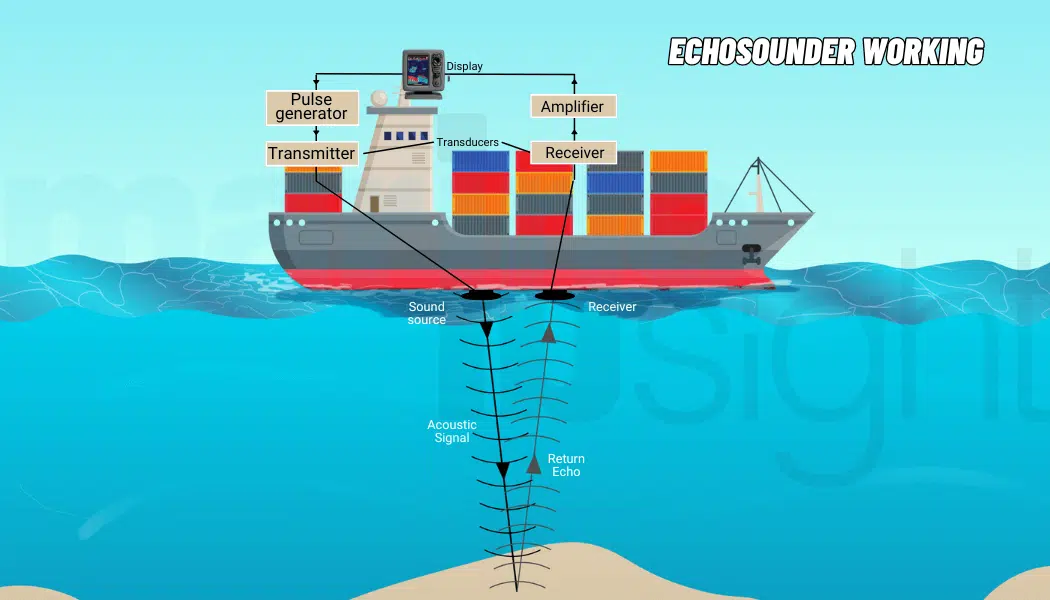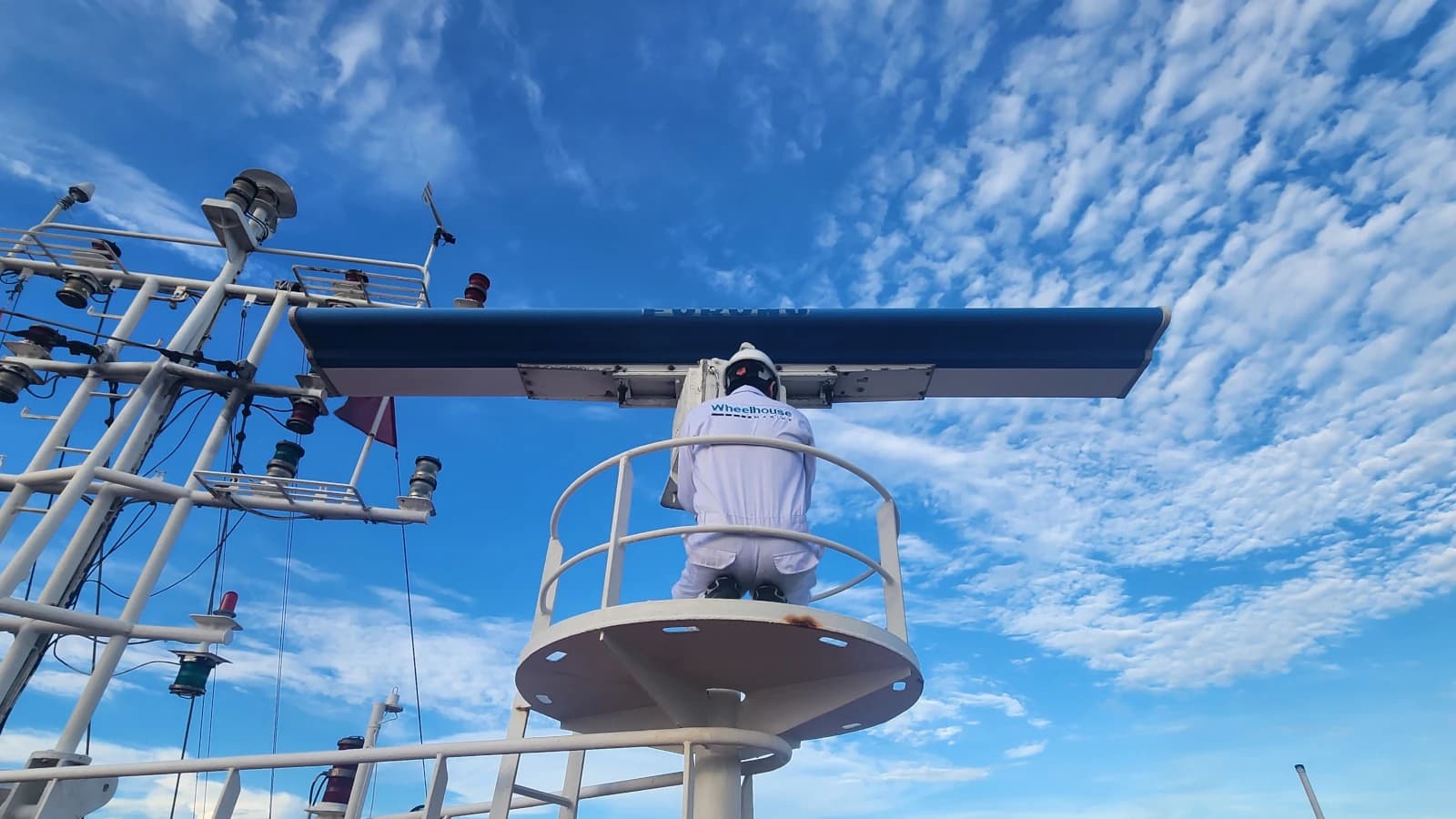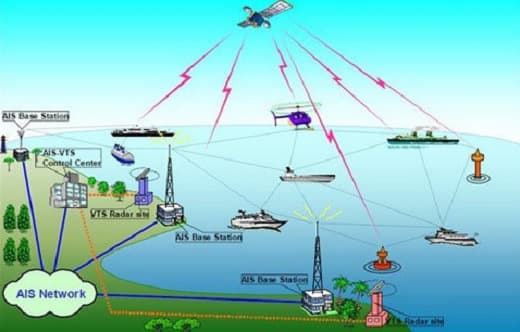Maritime Echosounder: Technical Analysis of Dual Frequency and UKC Control

Controlling under keel clearance (UKC) through precise hydroacoustic signal analysis and seawater environment correction.
1. Introduction: Ensuring Hull Integrity
The Echosounder is a critical hydroacoustic device, mandated for commercial vessels under SOLAS Chapter V. Its role extends far beyond merely measuring water depth: it is the primary navigation tool for managing Under Keel Clearance (UKC)—the safe vertical distance between the vessel’s deepest point and the seabed. Accurate UKC assessment is foundational to avoiding serious grounding risks, especially when navigating shallow waters, channels, or approaching ports where tidal phenomena are complex.
This article delves into hydroacoustic principles, dual-frequency technology, physical sources of error, and advanced correction methods to ensure the reliability of depth data.
2. Hydroacoustic Operating Principle and Basic Formula
The Echosounder operates on the principle of transmitting an acoustic pulse to the seabed and measuring the time it takes for the reflected pulse (echo) to return.
2.1. Depth Calculation Formula and SoS Dependence
The depth () is calculated by the basic formula:
Where:
- : Speed of Sound in Seawater (SoS).
- : Total two-way travel time of the acoustic pulse.
The accuracy of the depth measurement is directly dependent on the precise determination of the SoS (). Sound speed is influenced by three environmental factors: Temperature, Salinity, and Pressure. Small errors in estimating can lead to significant discrepancies in the depth result, especially in deep water.
2.2. Frequency and Resolution
- Low Frequency (e.g., 30kHz - 50kHz): Pulses have longer wavelengths and suffer less energy attenuation. This allows for more effective penetration through the water column and soft bottom layers, ideal for measuring deep water. However, it offers lower resolution.
- High Frequency (e.g., 100kHz - 200kHz): Pulses have shorter wavelengths, providing high resolution (the ability to distinguish small objects near the bottom) but are attenuated more quickly, effective mainly in shallow water.
- Dual Frequency Systems: Professional Echosounders (such as those from Furuno or Koden) often use two frequencies simultaneously to ensure reliability: Low frequency to measure overall depth and high frequency to confirm the hard bottom depth and under-keel details.
3. Sources of Error and Correction Techniques
To ensure safe UKC, Echosounders must be rigorously calibrated to eliminate systematic and random error sources.
3.1. Keel Error Correction
The Echosounder measures depth from the position of the Transducer. The actual depth under keel (UKC) must be corrected by subtracting the distance from the Transducer to the Keel (Keel Offset) and adding the current draught. Errors in this manual entry are a common source of systematic error.
3.2. Speed of Sound (SoS) Correction
- Physical Issue: In oceanic areas, SoS can change with depth due to variations in pressure and temperature (Sound Velocity Profile - SVP).
- Technical Solution: Advanced systems use a Sound Velocity Sensor or dedicated probes (Sound Velocity Probe) to directly measure the SVP of the water column. This data is then used by the Echosounder processor to correct the travel time () into the true depth ().
3.3. Noise and Reflection Errors
- Propeller Noise: Noise and aeration from the propeller can disrupt or create false echoes. The precise mounting location of the Transducer is crucial.
- False Echoes: Can occur due to suspended matter in the water (fish, debris) or due to acoustic pulses reflecting multiple times between the hull and the seabed.
4. Tactical UKC Management and Integrated Applications
UKC management requires the integration of depth data with vessel operational information.
4.1. UKC and the Influence of Squat Effect
The actual under keel clearance is reduced when the vessel is underway due to the Squat Effect (the vessel sinking into the water while moving), especially at high speeds and in shallow/narrow channels. The depth measured by the Echosounder must be assessed alongside the estimated Squat effect to determine a safe UKC.
4.2. Integration of Depth Data into ECDIS
- Optimal Safety: Real-time depth data is transmitted and displayed directly on the Electronic Chart Display and Information System (ECDIS). This allows the officer to set Safety Contours and Depth Alarms, providing instant alerts when the vessel enters dangerously shallow water.
- Data Reporting: Modern Echosounders have the capability to log and store depth data along with the GNSS position, useful for post-voyage hydrographic checks and VDR (Voyage Data Recorder) support.
5. International Standards and Equipment Selection
Echosounders must strictly comply with IMO Performance Standards (Resolution A.224(VII)) and related IEC technical standards.
| Manufacturer | Key Technical Strengths | Applications | | :----------- | :---------------------------------------------------------------------------------------------------------------------------------------------- | :---------------------------------------- | | Furuno | Dual/Multi-frequency systems, advanced digital noise filtering capability, deep integration into Integrated Bridge Systems (INS). | Large commercial vessels, survey vessels. | | JRC | High reliability, focus on Bottom Discrimination features, useful for fishing and research vessels. | Container ships, research vessels. | | Koden | Specialized Echosounders for fishing vessels with detailed display of suspended objects and bottom structure (e.g., Fish Finder functionality). | Fishing vessels, coastal workboats. |
6. Partnering with Wheelhouse
Wheelhouse provides professional Echosounder solutions, calibrated to achieve the highest accuracy according to IMO/IEC standards. We assist you with:
- SoS Optimization: Implementing SoS sensors or correction methods to minimize measurement errors.
- UKC Consultation: Ensuring the system is correctly configured with Keel Offsets and effectively integrates depth safety alarms into the ECDIS.
We are committed to providing reliable depth data, helping you maintain a safe UKC and operate your vessel safely and efficiently.
To learn more about Echosounder technologies, UKC control solutions, and technical support services, please visit our Solutions page.


